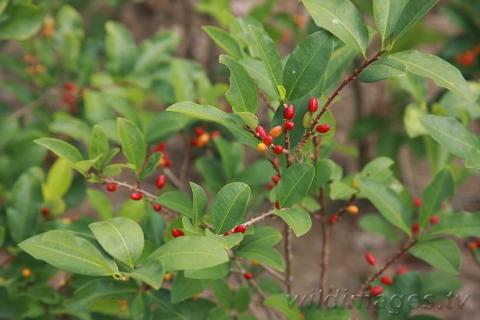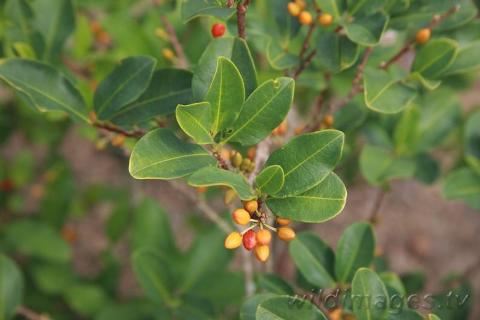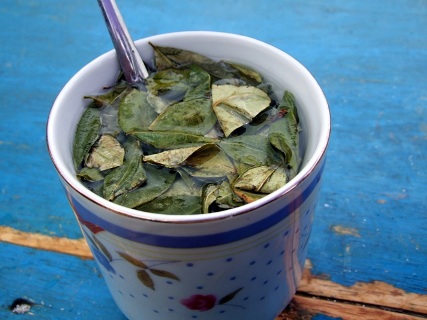Interactions
Insects
While the alkaloids in Erythroxylum coca provide the
plant with powerful protection, some organisms still find a way
to take
 advantage it.
advantage it.
One of the most serous threats to the coca plant is the larvae
of a moth by the name of Eloria noyesi. This moth lives
through out the region of South America where coca is grown and
likes to feed exclusively on E. coca. The larvae likes
to primarily feed on the leaves or shoots of the bush, and is
capable of devouring up to 50 leaves in it's lifetime. If Eloria
noyesiis repeatedly attacks the plant, even a strong
and healthy plant can die.
Another enemy of the Truxillo species of the coca plant is the
beetle Aegoidus pacificus. After the beetle lays it's
eggs in the bark of the coca plant, the larvae burrow into the
stem and not only do physical damage to the plant, but also
allow for an infestation of pathogenic fungi. This infestation
usually results in the death of the coca plant.
The larvae of Eucleodora coca, a fly, also
poses a threat to E. truxillense. The larvae of this
fly spend their entire lives feeding on the shoots and leaves of
the coca plant, with major infestations usually occurring
between April and August.
 The leaf-cutting ant, Acromyrmex, has also been reported to
cause the coca plant harm. Besides destroying the leaves, these
ants cut into the roots and the bark, leaving the plant
seriously damaged and vulnerable to infections.
The leaf-cutting ant, Acromyrmex, has also been reported to
cause the coca plant harm. Besides destroying the leaves, these
ants cut into the roots and the bark, leaving the plant
seriously damaged and vulnerable to infections.
Most other insects which do attack the coca plant only do so out
of deficiency of their normal food supply. Insects like spider
mites, grasshoppers, leafhoppers, and beetles are often times
find it necessary to eat the coca plant or face starvation.
Fungi
Besides insects, the coca plant is also vulnerable to numerous of pathogenic
fungi. Wet seasons bring the greatest threat to the plant since the fungi
generally thrive in wet or moist conditions. The fungus that is responsible
for the most harm to E. coca is known as "withces broom".
Uses of the coca plant
The integration of coca into human lives dates back farther than we can imagine.
The most notable origin of the use of E. coca is by the Inca
Empire, where coca plant was a vital part of religious cosmology, which at
first was restricted to nobility and few other higher classes, but later
spread to practically everyone.
 Besides the religious practices of the Andean tribes, E. coca has
been used for several different medicinal purposes. Even now coca leaves and
it's alkaloids are being used by some of the communities in the Andes for
warding off fatigue, thirst, and hunger. When the coca made it's way to
Europe, its alkaloid, cocaine, was found to be a powerful anesthetic for use
in surgery. It was said to be useful in overcoming many forms of asthma,
gastric derangements, pain, and as a cure for morphine or alcohol cravings.
In our current day and age, cocaine has very little medical use and has been
replaced by synthetic anesthetics, such as benzocaine, tetracaine, and
proparacaine, which do not poses as harmful side effects as cocaine.
Besides the religious practices of the Andean tribes, E. coca has
been used for several different medicinal purposes. Even now coca leaves and
it's alkaloids are being used by some of the communities in the Andes for
warding off fatigue, thirst, and hunger. When the coca made it's way to
Europe, its alkaloid, cocaine, was found to be a powerful anesthetic for use
in surgery. It was said to be useful in overcoming many forms of asthma,
gastric derangements, pain, and as a cure for morphine or alcohol cravings.
In our current day and age, cocaine has very little medical use and has been
replaced by synthetic anesthetics, such as benzocaine, tetracaine, and
proparacaine, which do not poses as harmful side effects as cocaine.
Click
here to find out about curare whose leaves are also used for medicinal
purposes.
The coca plant is also used for non-medicinal purposes as well. Several types of food, such as coca tea, granola bars and various candies are commercially manufactured, mostly in the Andes. Cosmetic and food industries also found a use for the coca plant, such as the de-cocainized coca leaf extract which is used as one of the flavoring ingredients of Coca-Cola. Probably one of the biggest uses of the coca plant is for its cocaine. In many countries, such as the United States and the UK. Cocaine is one of the most popular recreational drugs, only second to Cannabis.
Continue to Interesting Facts
Return to Reproduction
Return Home